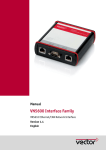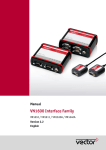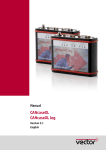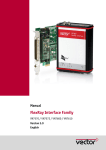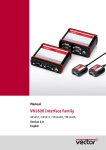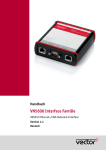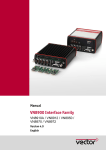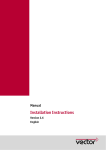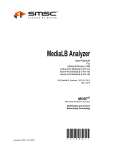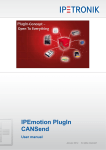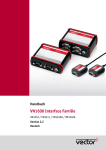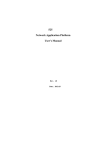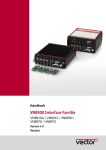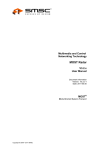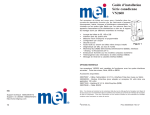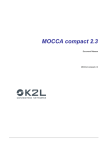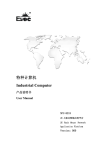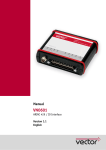Download Manual - Vector
Transcript
Manual VN2600 Interface Family MOST Interfaces VN2610/VN2640 Version 1.5 English Imprint Vector Informatik GmbH Ingersheimer Straße 24 D-70499 Stuttgart The information and data given in this user manual can be changed without prior notice. No part of this manual may be reproduced in any form or by any means without the written permission of the publisher, regardless of which method or which instruments, electronic or mechanical, are used. All technical information, drafts, etc. are liable to law of copyright protection. Copyright 2015, Vector Informatik GmbH. All rights reserved. Manual Contents Contents 1 Introduction 5 1.1 Safety Instructions and Hazard Warnings 1.1.1 Proper Use and Intended Purpose 1.1.2 Hazards 1.1.3 Disclaimer 6 6 6 6 1.2 About this User Manual 1.2.1 Certification 1.2.2 Warranty 1.2.3 Registered Trademarks 7 8 8 8 2 VN2600 Interface Family 9 2.1 Introduction to VN2600 Family 2.1.1 General Information 2.1.2 Scope of Delivery 2.1.3 Installation 2.1.4 Device Connectors (Rear) 2.1.5 Device Connectors (Front) 10 10 10 10 11 14 2.2 VN2610 2.2.1 2.2.2 2.2.3 2.2.4 2.2.5 2.2.6 Main Features Description Details Audio LEDs Technical Data 17 17 17 17 18 21 22 VN2640 2.3.1 2.3.2 2.3.3 2.3.4 2.3.5 2.3.6 Main Features Description Details Audio LEDs Technical Data 23 23 23 24 25 25 26 2.3 3 VN2600 Accessories 28 3.1 Accessories 29 4 Common Features 30 4.1 Time Synchronization 4.1.1 General Information 4.1.2 Software Sync 4.1.3 Hardware Sync 31 31 33 34 5 Driver Installation 36 5.1 Minimum Requirements 37 5.2 Hints 38 5.3 Vector Driver Setup 39 5.4 Vector Hardware Configuration 41 5.5 Loop Tests 5.5.1 CAN 43 43 © Vector Informatik GmbH Version 1.5 -3- Manual Introduction 5.5.2 5.5.3 5.5.4 FlexRay MOST Ethernet © Vector Informatik GmbH 46 47 48 Version 1.5 -4- Manual Introduction 1 Introduction In this chapter you find the following information: 1.1 Safety Instructions and Hazard Warnings Proper Use and Intended Purpose Hazards Disclaimer page 6 1.2 About this User Manual Certification Warranty Registered Trademarks page 7 © Vector Informatik GmbH Version 1.5 -5- Manual 1.1 Introduction Safety Instructions and Hazard Warnings Caution: In order to avoid personal injuries and damage to property, you have to read and understand the following safety instructions and hazard warnings prior to installation and use of this interface. Keep this documentation (manual) always near the interface. 1.1.1 Proper Use and Intended Purpose Caution: The interface is designed for analyzing, controlling and otherwise influencing control systems and electronic control units. This includes, inter alia, bus systems like CAN, LIN, K-Line, MOST, FlexRay, Ethernet and/or BroadR-Reach. The interface may only be operated in a closed state. In particular, printed circuits must not be visible. The interface may only be operated (i) according to the instructions and descriptions of this manual; (ii) with the electric power supply designed for the interface, e.g. USB-powered power supply; and (iii) with accessories manufactured or approved by Vector. The interface is exclusively designed for use by skilled personnel as its operation may result in serious personal injuries and damage to property. Therefore, only those persons may operate the interface who (i) have understood the possible effects of the actions which may be caused by the interface; (ii) are specifically trained in the handling with the interface, bus systems and the system intended to be influenced; and (iii) have sufficient experience in using the interface safely. The knowledge necessary for the operation of the interface can be acquired in workshops and internal or external seminars offered by Vector. Additional and interface specific information, such as „Known Issues“, are available in the „Vector KnowledgeBase“ on Vector´s website at www.vector.com. Please consult the „Vector KnowledgeBase“ for updated information prior to the operation of the interface. 1.1.2 Hazards Caution: The interface may control and/or otherwise influence the behavior of control systems and electronic control units. Serious hazards for life, body and property may arise, in particular, without limitation, by interventions in safety relevant systems (e.g. by deactivating or otherwise manipulating the engine management, steering, airbag and/or braking system) and/or if the interface is operated in public areas (e.g. public traffic, airspace). Therefore, you must always ensure that the interface is used in a safe manner. This includes, inter alia, the ability to put the system in which the interface is used into a safe state at any time (e.g. by „emergency shutdown“), in particular, without limitation, in the event of errors or hazards. Comply with all safety standards and public regulations which are relevant for the operation of the system. Before you operate the system in public areas, it should be tested on a site which is not accessible to the public and specifically prepared for performing test drives in order to reduce hazards. 1.1.3 Disclaimer Caution: Claims based on defects and liability claims against Vector are excluded to the extent damages or errors are caused by improper use of the interface or use not according to its intended purpose. The same applies to damages or errors arising from insufficient training or lack of experience of personnel using the interface. © Vector Informatik GmbH Version 1.5 -6- Manual 1.2 Introduction About this User Manual Conventions In the two following charts you will find the conventions used in the user manual regarding utilized spellings and symbols. Style Utilization bold Blocks, surface elements, window- and dialog names of the software. Accentuation of warnings and advices. [OK] Push buttons in brackets File|Save Notation for menus and menu entries Microsoft Legally protected proper names and side notes. Source Code File name and source code. Hyperlink Hyperlinks and references. <CTRL>+<S> Notation for shortcuts. Symbol Utilization Here you can obtain supplemental information. This symbol calls your attention to warnings. Here you can find additional information. Here is an example that has been prepared for you. Step-by-step instructions provide assistance at these points. Instructions on editing files are found at these points. This symbol warns you not to edit the specified file. © Vector Informatik GmbH Version 1.5 -7- Manual Introduction 1.2.1 Certification Certified Quality Vector Informatik GmbH has ISO 9001:2008 certification. The ISO standard is a Management System globally recognized standard. 1.2.2 Warranty Restriction of warranty We reserve the right to change the contents of the documentation and the software without notice. Vector Informatik GmbH assumes no liability for correct contents or damages which are resulted from the usage of the documentation. We are grateful for references to mistakes or for suggestions for improvement to be able to offer you even more efficient products in the future. 1.2.3 Registered Trademarks Registered trademarks All trademarks mentioned in this documentation and if necessary third party registered are absolutely subject to the conditions of each valid label right and the rights of particular registered proprietor. All trademarks, trade names or company names are or can be trademarks or registered trademarks of their particular proprietors. All rights which are not expressly allowed are reserved. If an explicit label of trademarks, which are used in this documentation, fails, should not mean that a name is free of third party rights. > © Vector Informatik GmbH Windows, Windows 7, Windows 8.1 are trademarks of the Microsoft Corporation. Version 1.5 -8- Manual VN2600 Interface Family 2 VN2600 Interface Family In this chapter you find the following information: 2.1 Introduction to VN2600 Family General Information Scope of Delivery Installation Device Connectors (Rear) Device Connectors (Front) page 10 2.2 VN2610 Main Features Description Details Audio LEDs Technical Data page 17 2.3 VN2640 Main Features Description Details Audio LEDs Technical Data page 23 © Vector Informatik GmbH Version 1.5 -9- Manual 2.1 VN2600 Interface Family Introduction to VN2600 Family 2.1.1 General Information VN2600 MOST Interface Family The devices of the VN2600 MOST Family are high-performance hardware interfaces for the analysis, simulation, and testing of MOST networks. Even at large quantities of data, several devices can be used simultaneously with short reaction times, which is especially advantageous for the analysis of ring position-dependent procedures and high-load tests. 2.1.2 Scope of Delivery Device and accessories > 1 x VN26xx MOST Interface (VN2610 or VN2640) > 1 x User manual English/German > 1 x Driver CD > 1 x Power supply 100…240 V AC, 12 V DC, 1.25 A > 1 x MOST fiber optic cable (1 x MOST 2+0 connector and 2 x HFBR 4531) > 2 x Fiber optic couplers for HFBR connectors > 1 x Power supply cable, 1.5 m with open end > 1x Toslink-S/PDIF fiber optic cable, 5 m, 2.2 mm POF > 1 x ECL cable, 1.5 m with stripped wires (only with VN2640), see accessories manual for further information 2.1.3 Installation Note: You can find a detailed description of the driver installation in the separate installation instructions at the end of this manual. © Vector Informatik GmbH Version 1.5 - 10 - Manual VN2600 Interface Family 2.1.4 Device Connectors (Rear) Rear Figure 1: 2x Power/Sync, Ethernet (only VN2640), 2x S/PDIF, and USB 2.1.4.1 Power Supply External power supply The VN26xx must be externally supplied by one of the two Power/Sync jacks on the rear of the device. A power supply via USB is not possible. After the VN26xx has been supplied with the startup voltage, any voltage dip does not disturb the device function (see the technical data of the according VN26xx MOST Interface in this manual). The device consumes about 7 W during full operation. Connectors Two identical and equivalent Binder connectors are available on the rear of the device. It does not matter which connector is used to supply the device. It is not possible to chain the power supply through the VN26xx (e. g. to operate several VN26xx interfaces on one power supply) due to internal diodes. Scheme of connector Figure 2: Scheme of Binder connector on the device rear Alternative supply Alternatively to the main supply, the VN26xx can be operated from other sources. For this purpose a power supply cable with stripped wires is included in the scope of delivery. © Vector Informatik GmbH Version 1.5 - 11 - Manual VN2600 Interface Family Power/Sync The pin assignment of the Power/Sync connector is as follows: Pin Assignment 2.1.4.2 1 Power supply (voltage) 2 Sync line, 5 V compatible 3 GND, ground of the power supply and of the sync line Sync (Time Synchronization) Note: Further information on time synchronization can be found in section Time Synchronization on page 31. 2.1.4.3 Ethernet (VN2640) Connection to the PC The Ethernet connector is reserved for future use. 2.1.4.4 S/PDIF (Audio) Digital by optical S/PDIF The devices of the VN2600 interface family have additional S/PDIF connectors (Toslink) for digital audio input to the MOST bus and digital audio output from the MOST bus. One stereo channel can be provided per connector through the optical S/PDIF connectors. This means that only the MSB and CSB for the left and right channel of the S/PDIF data stream can be routed to/from MOST via connection labels. The LSB and CUV bytes are omitted or transmitted as zeros. Both sampling frequencies of MOST and S/PDIF can be optionally equalized by two sample rate converters (SRC) to avoid clicks. The following operation modes are available: > MOST Timing Slave, S/PDIF Master (SRC off) > MOST Timing Slave, S/PDIF Slave (SRC on) > MOST Timing Master, S/PDIF Master (SRC off), MOST clock by quartz with 44.1 kHz or 48 kHz. > MOST Timing Master, S/PDIF Slave (SRC on), MOST clock by quartz with 44.1 kHz or 48 kHz. > MOST Timing Master, S/PDIF Slave (SRC off), MOST clock by S/PDIF (only VN2610). © Vector Informatik GmbH Version 1.5 - 12 - Manual 2.1.4.5 VN2600 Interface Family USB Connection to the PC In order to use the VN26xx MOST Interface, it must be connected to a USB port on the PC using the included USB cable. The device does not burden the PC's electrical power supply since it has to be externally supplied. USB3.0 Superspeed The VN26xx can be operated at a USB3.0 Superspeed connector, but the bandwidth is limited to USB3.0 Highspeed. USB2.0 Highspeed In order to use the VN26xx, the PC's USB port must be USB2.0 Highspeed compliant to make us of the MOST bandwidth. USB1.1 Fullspeed USB1.1 is not supported by the VN26xx MOST Interface. Due to the high data rate of MOST a USB1.1 connection is not sufficient. © Vector Informatik GmbH Version 1.5 - 13 - Manual VN2600 Interface Family 2.1.5 Device Connectors (Front) Front Figure 3: Optic fiber, ECL (only VN2640), and analog audio input/output 2.1.5.1 MOST Optic fiber In order to incorporate the VN26xx into an existing MOST network, the fiber optic cable of the MOST ring must be cut through between two nodes and the HFBR connectors attached (not included in the scope of delivery). Then, the Vector MOST fiber optic cable has to be connected with the VN26xx using the included coupling pieces (see accessories manual) and the fiber optic cable of the MOST network. Example Figure 4: Example of a connection. The signal direction and the correct connection of light output and light input respectively must be heeded here. The fibers of the MOST fiber optic cable are marked for easier identification (see accessories manual). Alternative Alternatively, the MOST 2+0 connector can be connected with a custom fiber optic cable. Note: For the function test (loop test) described in the installation instructions, the Rx and Tx fibers of the MOST fiber optic cable must be connected to each other using a coupler. Optical transmitter power The power of the optical transmitter can be lowered according to the MOST specification from 100% to 50% (-3 dB). © Vector Informatik GmbH Version 1.5 - 14 - Manual 2.1.5.2 Description VN2600 Interface Family Electrical Control Line (ECL) The VN2640 has an ECL port according to the MOST specification which is used for exchanging wake up and diagnostic information along the MOST ring. Use the included ECL cable with stripped wires to connect to this port. For further information please refer to the accessories manual included on the Vector Driver CD. The Vbat voltage has to be externally applied to pin 1 and supplies the ECL pull-ups and the transceiver. This allows testing the ECL in variable voltage scenarios such as engine starts. The voltage of Vbat can be in the range of 0 V … 30 V, but for a proper function it has be in the range of 5.5 V ... 30 V. Vbat is also protected against inverse polarity. Pin 3 (ECL) is an open collector bus. The internal output driver can drive the bus only to GND. To avoid high currents under faulty conditions it has an internal current limitation to 40 mA. High levels are generated with the internal or additional external pull-up resistors. Inside the VN2640 there are two pull-up resistors between Vbat and ECL. The first resistor with 60 kOhm is permanently connected. The second pull-up with 1.1k Ohm in parallel to the first resistor can be switched on by software. The ECL line is protected against inverse polarity and electromagnetic discharges of 4 kV. The used transceiver (ATA6664) uses Vbat as reference voltage for its receiver. A save low level is detected if the ECL line is below 40 % of Vbat. A save high level is detected if the ECL line is above 60 % of Vbat. The detected logic state is undefined between 40 % and 60 % of Vbat. Pin 3 (GND) of the ECL connector is the reference ground for Vbat and ECL. Figure 5: Scheme of the ECL port © Vector Informatik GmbH Version 1.5 - 15 - Manual 2.1.5.3 VN2600 Interface Family Line In and Line Out Analog by Line In and Line Out The VN26xx offers a line in and line out/headphone connector for input and output of analog audio signals. Scheme Figure 6: Scheme of line in and line out Connector signal assignment The connection of the analog signals to the device is done via two 3.5 mm stereo jacks. The signal assignment is as follows. Figure 7: Signal assignment on the stereo jack Note: Further information on signal routing can be found in the according device description of this manual (VN2610, VN2640). © Vector Informatik GmbH Version 1.5 - 16 - Manual 2.2 VN2600 Interface Family VN2610 2.2.1 Main Features VN2610 features The main features of the VN2610 MOST Interface are: > MOST25 interface > Routing engine for audio > Sending up to 1400 control messages per second > Receiving up to 900 control messages per second 2.2.2 Description Power up After supplying the power, the VN2610 immediately switches into bypass mode. The power of the optical transmitter building block (FOT) is set to 100% (0 dB). This state is maintained until the application sets another configuration. The status LEDs always display the current state of the device and of the ring network (lock/unlock). Node and spy position The VN2610 supports the simultaneous operation of the node mode (master or slave) and the spy mode for all messages and packets transmitted on the MOST bus. The control spy follows the transmitting node of the VN2610. Example Figure 8: Example for spy/node application 2.2.3 Details OS8104 The used MOST network controller is an OS8104, which guarantees full compatibility to existing MOST systems. The device can be used as a timing master, timing slave or in bypass operation. Parallel to each of these three modes, all control messages and asynchronous packets can be recorded online via a suitable application (e. g. CANoe) without influencing the MOST bus using the spy function. In master mode, a frame frequency of 44.1 kHz or 48 kHz can be set. Amount of control messages If the device is a visible node in master or slave mode in the MOST network, up to 1400 control messages per second can be received and up to 900 control messages per second can be transmitted. The usable bandwidth is shared between transmission and receiving. The bandwidth is determined by the OS8104. © Vector Informatik GmbH Version 1.5 - 17 - Manual VN2600 Interface Family Packet length Asynchronous packets like control messages can only be transmitted in master and slave mode. Receiving is also possible in bypass mode and always provides all packets to the application which are transmitted via MOST. Transmission and receiving are supported with packet lengths up to 1014 data bytes (1024 bytes packet length) at full bandwidth (1.45 MB/s). Synchronous channels Multi-channel synchronous data streams can be analyzed with or without time stamps; test signals for synchronous channels in the PC can also be generated via USB. This allows for example: > Logging of the complete MOST data communication for offline analysis and error logging for suppliers > Test of transfer functions of digital-analog or analog-digital converters > Implementation of optimized flash algorithms with full bandwidth in production (1...60 bytes) > ECU diagnostics via hidden communication in idle synchronous channels > Implementation and test of DTCP algorithms with the PC > Creation of test signals of any complexity 2.2.4 Audio S/PDIF synchronization It is possible to synchronize the S/PDIF output to the S/PDIF input to avoid synchronization errors in special cases. Synchronization errors occur when neither the S/PDIF source nor the S/PDIF drain or both at the same time synchronize to their inputs. For the following standard cases the synchronization is automatically set. In other cases the activation and deactivation of synchronization respectively is done by the user in the application. Audio analysis and audio stimulation as MOST slave SRC off SRC on S/PDIF dev ice S /PDIF d evic e Figure 9: Left: audio analysis as MOST slave, right: the audio stimulation as MOST slave with not synchronized source © Vector Informatik GmbH Version 1.5 - 18 - Manual VN2600 Interface Family Audio analysis and audio stimulation as MOST master SRC off SRC on S/PDIF devic e S/PDIF dev ice Figure 10: Left: audio analysis as MOST master (44.1 kHz/48 kHz), right: audio stimulation as MOST master with fixed frame rate (44.1 kHz/48 kHz) and not synchronized source Audio stimulation as MOST master with clock from S/PDIF SRC off S/PDIF device Figure 11: Audio stimulation as MOST master with S/PDIF clock Legend Clock Clock source Data Data source Analog by line in and line out Analog signals fed through the line in are first digitalized and can be routed via the routing engine of the OS8104 on the MOST bus then. Digital audio signals from MOST can also be converted into analog audio signals with adjustable volume, provided on the line out connector. With the built-in amplifier it is also possible to operate headphones (16 Ω, 150 mW) on the line out. Routing engine OS8104 In order to transmit and receive asynchronous packets via the used MOST network controller (OS8104), the controller's routing table must be set to particular values in the range of MRT0x44 to MRT0x7F. This is automatically done by the firmware on power up. Caution: The range MRT0x44 to MRT0x7F must not be manually edited! A change of these values can interrupt the receiving and transmission of asynchronous packets, and compromises other aspects of the operation of the VN2610! The routing of synchronous channels via the line in or line out/headphone jacks of the VN2610 is controlled by the routing engine of the MOST network controller. For this purpose the following register values and addresses have to be used: © Vector Informatik GmbH Version 1.5 - 19 - Manual Line in and line out VN2600 Interface Family Addresses in the routing engine for line in and line out: Source/Drain Line IN Channel Byte Left MSB MRA0x40 LSB MRA0x41 MSB MRA0x42 LSB MRA0x43 MSB MRT0x40 LSB MRT0x41 MSB MRT0x42 LSB MRT0x43 Right Line OUT Left Right S/PDIF Addresses in the routing engine for S/PDIF: Source/Drain Channel Left S/PDIF IN Right Left S/PDIF OUT Right Abbreviations Address in routing engine Byte Address in routing engine MSB MRA0x44 CSB MRA0x45 LSB MRA0x46 CUV MRA0x47 MSB MRA0x48 CSB MRA0x49 LSB MRA0x4A CUV MRA0x4B MSB MRT0x44 CSB MRT0x45 LSB MRT0x46 CUV MRT0x47 MSB MRT0x48 CSB MRT0x49 LSB MRT0x4A CUV MRT0x4B MSB = Most Significant Byte CSB = Center Significant Byte LSB = Least Significant Byte CUV (S/PDIF) = Channel Status Data/User Data/Validity © Vector Informatik GmbH Version 1.5 - 20 - Manual Firmware VN2600 Interface Family Used address range: Description Address in routing engine reserved for firmware MRT0x4C reserved for firmware … reserved for firmware MRT0x7F 2.2.5 LEDs Device state Legend The VN2610 has five LEDs that indicate the state of the device: LED Color State Meaning Lock Green OFF Device is not synchronized to the master's clock Lock Green ON Device is synchronized with the master Master Yellow OFF Device is either slave or bypass1 Master Yellow ON Device is configured as master Slave Yellow OFF Device is either master or bypass1 Slave Yellow ON Device is configured as slave Rx/Tx Green OFF No packets or messages transmitted Rx/Tx Red (( )) Packet or message received (Rx) Rx/Tx Green (( )) Packet or message transmitted (Tx) Rx/Tx Orange (( )) Packet or message received and transmitted Power Green OFF Device is not ready for operation Power Green (( )) Device is initializing Power Green ON Device is ready for operation (( )) Pulse, blinking. 1 In bypass mode, neither the master nor the slave LED illuminates. © Vector Informatik GmbH Version 1.5 - 21 - Manual VN2600 Interface Family 2.2.6 Technical Data MOST network controller OS8104 Number of MOST channels 1 Operating modes Master, slave, spy, bypass Spy for Control- und asynchronous channel Can also be activated separately parallel to other modes at any time Control messages (master / slave) Up to 985/s (Tx), up to 1453/s (Rx) Control messages (spy) Full bandwidth receivable Asynchronous packets Packet length up to 1014 bytes Up to 9600 packets/s (Tx), Up to 25000 packets/s (Rx), Up to 1.45 MB/s (Tx and/or Rx) Synchronous channels USB: 1..60 byte per frame, Tx and/or Rx, with optional Rx time stamps 1x Line In 1x Line Out/Headphone 1 x S/PDIF optical IN 1 x S/PDIF optical OUT 2 x sample rate converter for S/PDIF Line in connector 3.5 mm stereo jack Line out/headphone connector 3.5 mm stereo jack S/PDIF In Connector Toslink, optical, 16 bit, stereo MOST connector Standard MOST 2+0, Full Physical Compliant Mix401 Infineon Master frame rates Fs, 44.1 and 48 kHz PC interface USB2.0, USB1.1 (reduced bandwidth) Temperature range Operation Storage Relative humidity of ambient air 15 %...90 %, non-condensing Software requirements Windows 7, (32 bit / 64 bit) Windows 8.1, (32 bit / 64 bit) Dimensions (LxWxH) Approx. 140 x 105 x 32 mm Power supply Externally (not by USB) Startup : 7 V…50 V, approx. 5 W Operation : 5 V…50 V, approx. 7 W Time stamp accuracy 1 µs Input impedance 21.8 kΩ Input voltage Max. 2000 mVrms Output voltage Max. 4000 mVpp Output power 150 mW @ 16 Ω Weight 0.36 kg © Vector Informatik GmbH Version 1.5 : -20 °C ... +70 °C : -40 °C … +85 °C - 22 - Manual 2.3 VN2600 Interface Family VN2640 2.3.1 Main Features VN2640 features The main features of the VN2640 MOST Interface are: > MOST150 interface > Vector Spy150-IP-core in the FPGA > ECL for exchanging wake up and diagnostic information > Sending up to 800 control messages per second (depending on the driver version) > Receiving up to 800 control messages per second (depending on the driver version) 2.3.2 Description Power up After supplying the power, the VN2640 switches immediately into bypass mode. The power of the optical transmitter building block (FOT) is set to 100% (0 dB). This state is maintained until the application sets another configuration. The status LEDs always display the current state of the device and of the ring network (lock/unlock). The VN2640 will support the configuration of the power up mode with a future driver release. With this feature, the VN2640 can start either in (static-)master, slave or bypass mode to prevent later unlocks when the ring has to be accessed. This is useful when the VN2640 has to be connected to a PC when a ring failed and unlocking would reset the problem. To set the INIC power up reference frequency to either 44.1 kHz or 48 kHz a switch inside the VN2640 can be used (factory setting 48 kHz). To change the setting, the device must be opened. This setting can be overridden by the application. Switch for reference frequency Figure 12: Switching the reference frequency Node and The VN2640 supports the simultaneous operation of the node mode ((static-)master © Vector Informatik GmbH Version 1.5 - 23 - Manual spy position VN2600 Interface Family or slave) and the spy mode for all messages and packets transmitted on the MOST bus. The spy follows the transmitting node of the VN2640. Example Figure 13: Example for spy/node application 2.3.3 Details OS81110 The used MOST network controller is an OS81110 INIC, which guarantees full compatibility to existing MOST150 systems. The OS81110 is connected to a low power FPGA via a Vector proprietary MediaLB+® IP-core with the maximum possible bandwidth of 400 Mbps (8192 Fs). The firmware of the OS81110 INIC is automatically updated by the driver. Spy The Vector proprietary Spy150-IP-core in the FPGA decodes and extracts all bits and bytes as well as ring states and statistics for ring analyses. This information is forwarded with low latency and high bandwidth to the PC. Unlock An FPGA internal unlock generator accurately destroys two of three preambles in order to cause unlocks in following devices without that their PLLs drift apart. In this way precise unlock times can be generated. Galvanic isolation USB/analog audio, power, sync, Ethernet, and ECL are all individually and galvanically isolated from each other to prevent high current ground loops especially in cars. Such ground loops can destroy the VN2640, the notebook and the ECUs if the VN2640 and the notebook are supplied at different positions in the car for example. The housing of the VN2640 is connected to the USB/analog audio potential. Modes and functions The device can be used as a timing master, timing slave, as a static master or in bypass operation. Parallel to each of these modes, all control messages, asynchronous data and Ethernet packets can be recorded online via a suitable application (e. g. CANoe) without influencing the MOST bus using the spy function. In (static-)master mode, a frame frequency of 44.1 kHz or 48 kHz can be set. Amount of control messages When the device is a visible node in (static-)master or slave mode in the MOST network, up to 800 control messages per second can be received and transmitted (depending on the driver version). The bandwidth is limited by the OS81110 INIC. Packet length Asynchronous data and Ethernet packets can only be transmitted in (static-)master and slave mode. Receiving is also possible in bypass mode which always provides © Vector Informatik GmbH Version 1.5 - 24 - Manual VN2600 Interface Family all packets to the application that are transmitted on the ring. Transmission and reception are supported with packet lengths up to 1524 bytes payload for MOST Data Packets (MDP) and up to 1506 bytes payload for MOST Ethernet Packets (MEP) at a maximum bandwidth limited by USB/INIC. 2.3.4 Audio Analog by line in and line out Analog signals fed through the line in are first digitalized and can be routed via connection labels of the OS81110 INIC to the MOST ring. Digital audio signals from MOST can also be converted into analog audio signals with adjustable volume, provided on the line out connector. With the built-in amplifier it is also possible to operate headphones (16 Ω, 150 mW) on the line out. Digital line in and line out signals have a 2 x 16 bit resolution. 2.3.5 LEDs Device state Legend The VN2640 has five LEDs that indicate the state of the device: LED Color State Meaning Lock Green OFF Device is not synchronized to the master's clock Lock Green ON Device is synchronized with the master Master Yellow OFF Device is either slave or bypass1 Master Yellow ON Device is configured as master Slave Yellow OFF Device is either master or bypass1 Slave Yellow ON Device is configured as slave Rx/Tx Green OFF No packets or messages transmitted Rx/Tx Red (( )) Packet or message received (Rx) Rx/Tx Green (( )) Packet or message transmitted (Tx) Rx/Tx Orange (( )) Packet or message received and transmitted Power Green OFF Device is not ready for operation Power Green (( )) Device is initializing Power Green ON Device is ready for operation (( )) Pulse, blinking. 1 In bypass mode, neither the master nor the slave LED illuminates. © Vector Informatik GmbH Version 1.5 - 25 - Manual VN2600 Interface Family 2.3.6 Technical Data MOST network controller OS81110 INIC150 Number of MOST channels 1 Operating modes Master, static master, slave, spy, bypass Spy for Control- und asynchronous channel Can also be activated separately parallel to other modes at any time Control messages (master / slave) Up to 800/s; limited by INIC (depending on the driver version) Control messages (spy) Full bandwidth receivable Asynchronous data and Ethernet packets (master / slave) Packet length up to 1524 /1506 payload bytes. Up to 24000 packets/s ; limited by INIC (Tx and/or Rx); (depending on the driver version) Asynchronous data and Ethernet packets (spy) Full bandwidth receivable; limited by USB Synchronous channels 1x Line In 1x Line Out/Headphone 1x S/PDIF optical IN 1x S/PDIF optical OUT 2x sample rate converter for S/PDIF Line in connector 3.5 mm stereo jack Line out/headphone connector 3.5 mm stereo jack S/PDIF In Connector Toslink, optical, 16 bit, stereo MOST connector Standard MOST 2+0, Full Physical Compliant AFBR-1150L / AFBR-2150L Infineon Master frame rates Fs, 44.1 and 48 kHz PC interface USB2.0 Highspeed USB1.1 not supported Ethernet (currently not supported) Temperature range Operation Storage Relative humidity of ambient air 15 %...90 %, non-condensing Software requirements Windows 7, (32 bit / 64 bit) Windows 8.1, (32 bit / 64 bit) Dimensions (LxWxH) Approx. 140 x 105 x 32 mm Power supply Externally (not by USB) Startup : 7 V…50 V, approx. 7 W Operation : 5 V…50 V, approx. 7 W Port isolation USB/analog audio connected to housing. Power, sync, Ethernet and ECL are on separately isolated isles. Time stamp accuracy 1 µs with hardware synchronization Line in impedance 11.2 kΩ Line in voltage Max. 1000 mVp © Vector Informatik GmbH Version 1.5 : -40 °C ... +60 °C : -40 °C ... +85 °C - 26 - Manual VN2600 Interface Family Line out voltage Max. 447 mVpp Line out power 6 W @ 16 Ohm Weight 0.36 kg Ethernet* 10/100 Base-TX with Auto-MDIX (crossing det.) support; no device control possible ECL connector 0 V ... 30 V to GND Vbat (pin 1) Voltage protection ESD 4 kV Current limiting 40 mA (polyfuse) ECL signal (pin 2) Transceiver ATA6664 Pull up resistor 60 kOhm permanent; optional 1.1 kOhm in parallel to Vbat Voltage protection ESD 4 kV Current limiting 40 mA (polyfuse) High level 0.6 * Vbat ... 30 V (ATA6664) Low level 0 V … 0.4 * Vbat (ATA6664) Reference to Vbat and ECL signal GND (pin 3) © Vector Informatik GmbH Version 1.5 - 27 - Manual VN2600 Accessories 3 VN2600 Accessories In this chapter you find the following information: 3.1 Accessories © Vector Informatik GmbH page 29 Version 1.5 - 28 - Manual 3.1 VN2600 Accessories Accessories Reference: Further information on the available accessories can be found in the separate accessories manual on the driver CD in \Documentation\Accessories. © Vector Informatik GmbH Version 1.5 - 29 - Manual Common Features 4 Common Features In this chapter you find the following information: 4.1 Time Synchronization General Information Software Sync Hardware Sync © Vector Informatik GmbH page 31 Version 1.5 - 30 - Manual 4.1 Common Features Time Synchronization 4.1.1 General Information Time stamps and events Time stamps are useful when analyzing incoming or outgoing data or event sequences on a specific bus. Figure 14: Time stamps of two CAN channels in CANalyzer Generating time stamps Each event which is sent or received by a Vector network interface has an accurate time stamp. Time stamps are generated for each channel in the Vector network interface. The base for these time stamps is a common hardware clock in the device. Figure 15: Common time stamp clock for each channel If the measurement setup requires more than one Vector network interface, a synchronization of all connected interfaces and their hardware clocks is needed. Due to manufacturing and temperature tolerances, the hardware clocks may vary in speed, so time stamps of various Vector devices drift over time. © Vector Informatik GmbH Version 1.5 - 31 - Manual Common Features Figure 16: Example of unsynchronized network interfaces. Independent time stamps drift apart To compensate for these time stamp deviations between the Vector network interfaces, the time stamps can be either synchronized by software or by hardware (see next section). Note: The accuracy of the software sync is typically in range of 100 µs. Note: The accuracy of the hardware sync is typically in range of 1 µs. © Vector Informatik GmbH Version 1.5 - 32 - Manual Common Features 4.1.2 Software Sync Synchronization by software The software time synchronization is driver-based and available for all applications without any restrictions. The time stamp deviations from different Vector network interfaces are calculated and synchronized to the common PC clock. For this purpose no further hardware setup is required. Figure 17: Time stamps of devices are synchronized to the PC clock (accuracy in range of 100 µs) The setting of the software time synchronization can be changed in the Vector Hardware Config tool in General information | Settings | Software time synchronization. Figure 18: Switching on the software synchronization > YES The software time synchronization is active. > NO The software time synchronization is not active. Use this setting only if the Vector network interfaces are being synchronized over the sync line or if only a single device is used. © Vector Informatik GmbH Version 1.5 - 33 - Manual Common Features 4.1.3 Hardware Sync Synchronization by hardware A more accurate time synchronization of multiple devices is provided by the hardware synchronization which has to be supported by the application (e. g CANalyzer, CANoe). Two Vector network interfaces can therefore be connected with the SYNCcableXL (see accessories manual, part number 05018). In order to synchronize up to five devices at the same time, a distribution box is available (see accessories manual, part number 05085). Figure 19: Example of a time synchronization with multiple devices Figure 20: Example of a time synchronization with VN8912 and additional devices © Vector Informatik GmbH Version 1.5 - 34 - Manual Common Features At each falling edge on the sync line which is initiated by the application, the Vector network interface generates a time stamp that is provided to the application. This allows the application to calculate the deviations between the network interfaces and to synchronize the time stamps to a common time base (master clock) which is defined by the application. Figure 21: Time stamps are synchronized to the master clock (accuracy in range of 1 µs) Note: The hardware synchronization must be supported by the application. For further information please refer to the relevant application manual. Please note that the software synchronization must be disabled (see Vector Hardware Config | General information | Settings | Software time synchronization) if the hardware synchronization is used. © Vector Informatik GmbH Version 1.5 - 35 - Manual Driver Installation 5 Driver Installation In this chapter you find the following information: 5.1 Minimum Requirements page 37 5.2 Hints page 38 5.3 Vector Driver Setup page 39 5.4 Vector Hardware Configuration page 41 5.5 Loop Tests CAN FlexRay MOST Ethernet page 43 © Vector Informatik GmbH Version 1.5 - 36 - Manual 5.1 Driver Installation Minimum Requirements Hardware Software CPU Pentium 4 or higher Memory 512 MB or more Network interface CANcardXL CANcardXLe CANboardXL PCI CANboardXL PCIe CANboardXL pxi CANcaseXL CANcaseXL log VN1610 VN1611 VN1630A VN1640A VN2610 VN2640 VN3300 VN3600 VN5610 VN7570 VN7572 VN7600 VN7610 VN8910A VN8912 Operating system Windows 7 (32/64 bit) Windows 8.1 (32/64 bit) Driver version 8.x Measurement application The devices can be run with several applications from Vector (e. g. CANoe, CANalyzer) or with measurement applications from other companies. The devices require a related license. Applications based on the Vector XL Driver Library can be run without a license. © Vector Informatik GmbH Version 1.5 : PCMCIA : ExpressCard 54 : PCI : PCI Express x1 : Compact PCI/PXI : USB : USB : USB : USB : USB : USB : USB : USB : PCI : USB : USB : PCI Express x1 : PCI Express x1 : USB : USB : USB : USB - 37 - Manual 5.2 Driver Installation Hints Note: Many desktop PCs have power managers which block the CPU for a specific time. This impairs accuracy of the time system. If your application has stringent timing requirements (e. g. time-driven sending of messages or time-driven evaluations), you have to deactivate these power managers. Power management settings may be contained in the BIOS setup or on the Control Panel of Windows 7 / Windows 8.1 (e. g. Power options). No further mention will be made of the power manager in this document. Info: Please note that you will need Administrator Rights for the following steps. © Vector Informatik GmbH Version 1.5 - 38 - Manual 5.3 Driver Installation Vector Driver Setup General information The Vector Driver Disk offers a driver setup which allows the installation or the removal of Vector devices. 1. Execute the driver setup from the autostart menu or directly from \Drivers\Setup.exe before the device is inserted or connected to the PC with the included USB cable. If you have already inserted or connected the device to the PC, the Windows found new Hardware wizard appears. Close this wizard and then execute the driver setup. 2. Click [Next] in the driver setup dialog. The initialization process starts. © Vector Informatik GmbH Version 1.5 - 39 - Manual Driver Installation 3. In the driver selection dialog select your devices to be installed (or to be uninstalled). 4. Click [Install] to execute the driver installation, or [Uninstall] to remove existing drivers. 5. A confirmation dialog appears. Click [Close] to exit. If the driver has been installed properly, the device can be inserted or connected to the PC with the included USB cable. The device is ready for operation now. © Vector Informatik GmbH Version 1.5 - 40 - Manual 5.4 Driver Installation Vector Hardware Configuration Executing Vector Hardware Config After the successful installation you will find the configuration application Vector Hardware in the Control Panel (see below). The tool gives you information about the connected and installed Vector devices. There are also several settings that can be changed. Control panel Windows 7 > Category view Windows Start | Control Panel | Hardware and Sound, click Vector Hardware in the list. > Symbols view Windows Start | Control Panel, click Vector Hardware in the list. > Category view <Windows key>+<X> | Control Panel | Hardware and Sound, click Vector Hardware in the list. > Symbols view <Windows key>+<X> | Control Panel, click Vector Hardware in the list. Control panel Windows 8.1 The tool is split into two windows. The left window lets you access the installed Vector devices, the right window displays the details of the selection. The following nodes are available in the left window: Hardware Each installed Vector device is shown in Hardware. Additional details of available channels are shown in a tree view. Status information on the device components and the channels are also shown in this dialog. Application In Application, all available applications are shown with their configured channels. If you click on an application, all of its channels are displayed in the right pane on the screen. General information The General information section contains general information on Vector devices and © Vector Informatik GmbH Version 1.5 - 41 - Manual Driver Installation applications. License The License section contains information on all current valid licenses. Note: You will find a detailed description of Vector Hardware Config in the online help (Help | Contents). © Vector Informatik GmbH Version 1.5 - 42 - Manual 5.5 Driver Installation Loop Tests Operating test The test described here can be performed to check the functional integrity of the driver and the device. This test is identical for Windows 7 / Windows 8.1 and independent of the used application. 5.5.1 CAN Device test Loop3.exe The operating test for CAN can be executed with the following devices: > CANcardXL > CANcardXLe > CANcaseXL > CANcaseXL log > CANboardXL Family > VN1610 > VN1630A > VN1640A > VN5610 > VN7570 > VN7572 > VN7600 > VN8910A > VN8912 Either two High-Speed or two Low-Speed transceivers are necessary for this functional test: 1. Connect two CAN channels with a suitable cable. If two High-Speed transceivers are being used, we recommend our CANcable 1 (CANcable 0 for Low-Speed transceivers). 2. Start \Drivers\Common\Loop3.exe from the driver CD. This program accesses the Vector devices and transmits CAN messages. 3. Select the connected CAN channels of the device(s) to be tested. 4. Set the appropriate baudrate depending on the transceiver being used (HighSpeed max. 1,000,000 Bd, Low-Speed max. 125,000 Bd). © Vector Informatik GmbH Version 1.5 - 43 - Manual Driver Installation 5. Click [Start]. 6. You will see statistical data in the lower part of the window if the system has been configured properly. Loop3 application © Vector Informatik GmbH Version 1.5 - 44 - Manual Driver Installation 7. The test procedure can be terminated with the [Stop] button. An OK should appear in the upper part of the window. © Vector Informatik GmbH Version 1.5 - 45 - Manual Driver Installation 5.5.2 FlexRay Device test FRLoop.exe The operating test for FlexRay can be executed with the following devices: > VN3300 > VN3600 > VN7570 > VN7572 > VN7600 > VN7610 > VN8910A with VN8970 > VN8912 with VN8970/VN8972 This operating test requires an inserted FRpiggy. 1. Remove the FlexRay cable if it is connected. 2. Start \Drivers\Common\FRLoop.exe from the driver CD. 3. Execute the test. 4. If no error messages occur, the operating test was successful. © Vector Informatik GmbH Version 1.5 - 46 - Manual Driver Installation 5.5.3 MOST Device test MLoop.exe The operating test for MOST can be executed with the following devices: > VN2610 > VN2640 This functional test requires a MOST fiber optic cable and a fiber coupler for HFBR connectors. 1. VN2610 Start \Drivers\Common\MLoop.exe from the driver CD VN2640 Start \Drivers\Common\M150Loop.exe from the driver CD. 2. Select the VN2610/VN2640 to be tested from the list of detected devices. 3. Click [Twinkle] and check if the power LED of the VN2610/VN2640 is blinking at least for one second. 4. Connect the MOST fiber optic cable with the VN2610/VN2640 device, select Master mode and check if the program displays the status Unlock. Check if red light comes out of the TX fiber of the MOST fiber optic cable. 5. Connect both ends of the fiber with one fiber coupler to a ring and check if the program displays the status Lock. 6. Close MLoop.exe with [Exit]. © Vector Informatik GmbH Version 1.5 - 47 - Manual Driver Installation 5.5.4 Ethernet Device test The operating test for Ethernet can be executed with the following devices: > VN5610 1. Connect both Ethernet channels of the VN5610 with an Ethernet cable. 2. Connect both BroadR-Reach channels at the D-SUB9 connector as follows: 3. Start \Drivers\Common\ETHloop.exe from the driver CD. 4. Select an installed VN5610 from the list. 5. Press [Twinkle] and check if the LED Status blinks. 6. Start the test by pressing the button [Start Test]. The test is successful if no error messages occur. © Vector Informatik GmbH Version 1.5 - 48 - Get more Information! Visit our Website for: > News > Products > Demo Software > Support > Training Classes > Addresses www.vector.com

















































